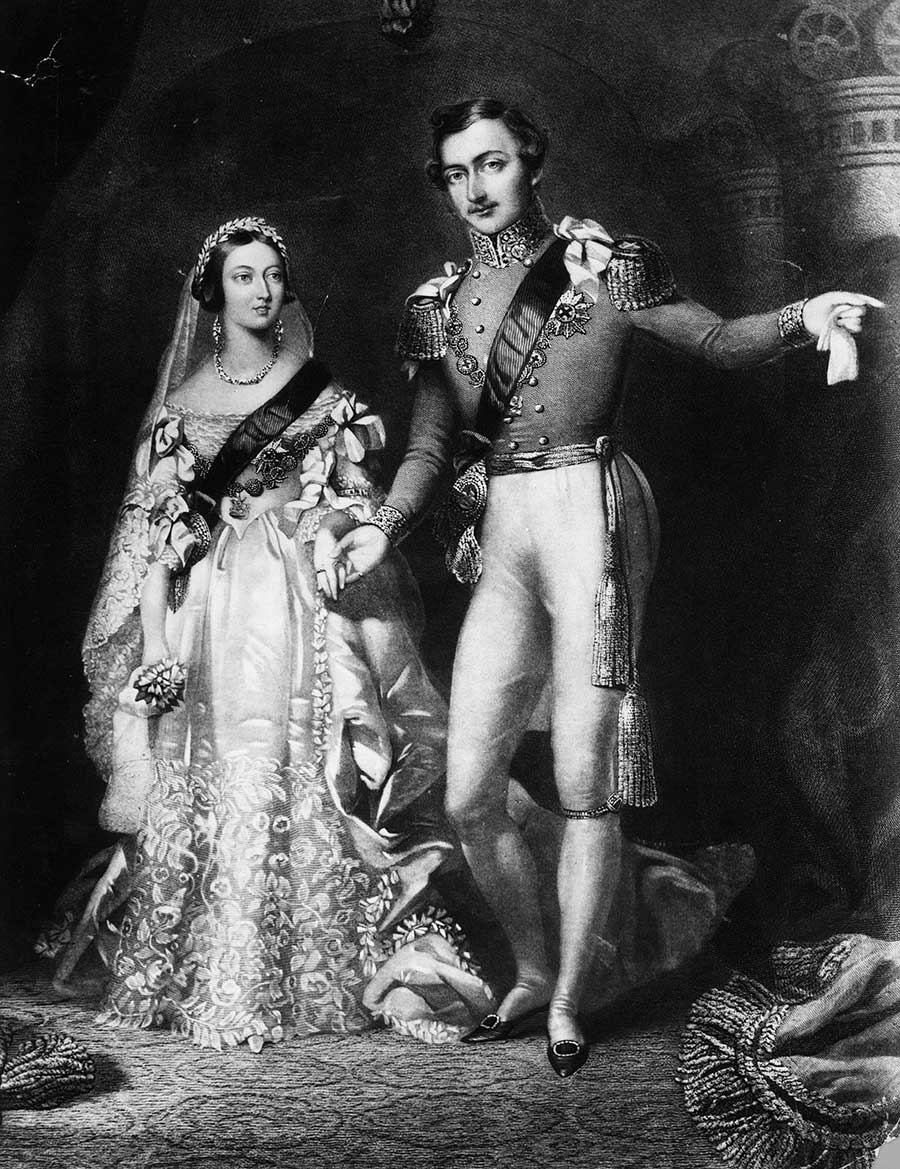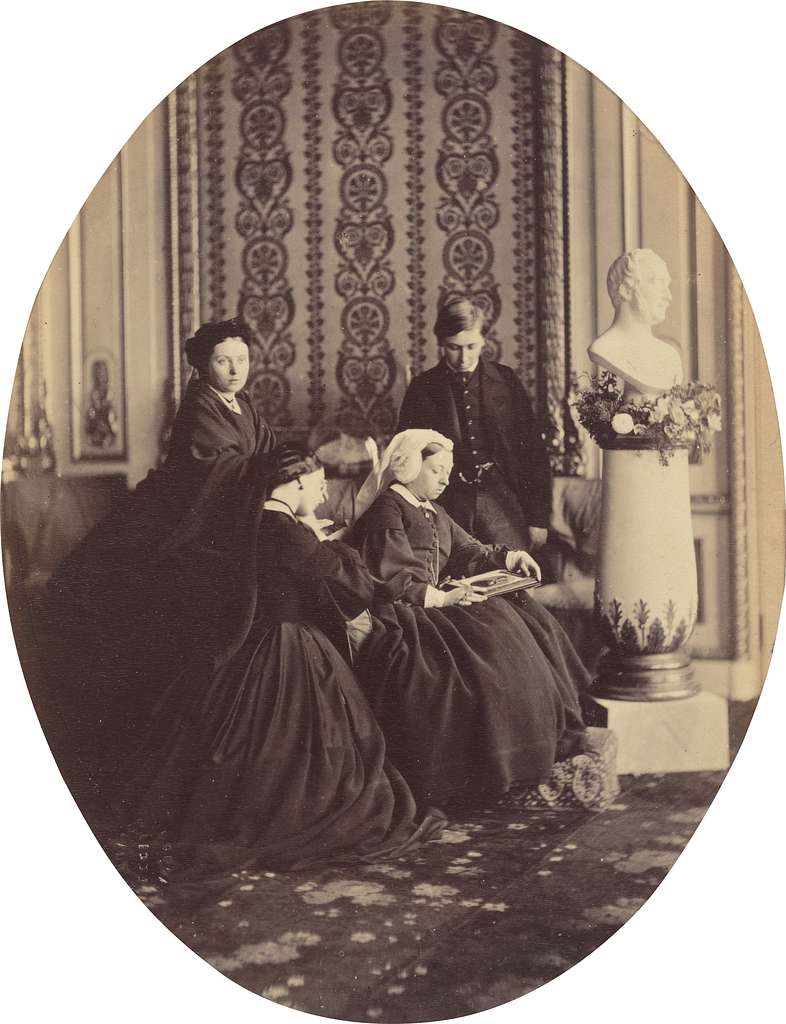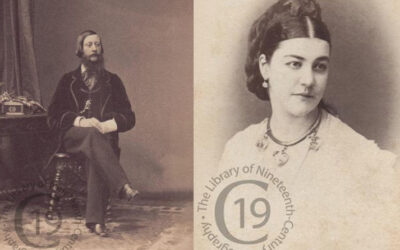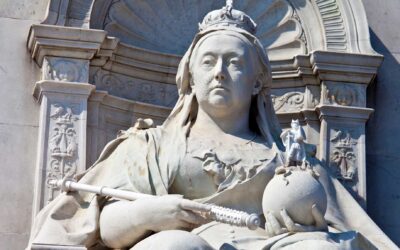Queen Victoria’s Dress Sense
“Queen Victoria’s dress sense – or rather, lack of it – was a subject that regularly provoked the despair of her courtiers. ”
When she visited her Uncle Leopold in Belgium soon after, the Queen’s fashion sense was no better. Her old-fashioned bonnets made her, at only 23, look like an old lady, thought Canning. The novelist Charlotte Bronte, who saw the queen’s carriage pass by in Brussels, recorded ‘a little stout, vivacious lady, very plainly dressed, not much dignity or pretension about her’.
The French Verdict on Victoria’s Style

Engraved by S Reynolds after F Lock, Public domain, via Wikimedia Commons
A fascinating account of the queen’s taste in clothes and the duties of a royal dresser during the 1850s can be found in the letters of Victoria’s German dresser, Frieda Arnold, whose editors complement her descriptions with contemporary descriptions from the press of some of the queen’s dresses. They note her preference for pink or blue ball gowns made of layers of tulle over silk, with the flounces and lace trimmings that she loved, and embroidered with her favourite flower motifs, such as roses, lilacs, jasmine, orchids and occasionally sewn in with diamonds.
Francis Grant, Public domain, via Wikimedia Commons: Queen Victoria on Horseback
The Queen’s Jewellery
There seems to have been no comment on the queen’s dress during her nine pregnancies, a fact which alone would have ensured her inability to dress very fashionably for the majority of time between 1840 and her last baby in 1857. Any acknowledgment of current fashion in her clothes stopped altogether, of course, when she was widowed in 1861; thereafter Victoria stuck to wearing what she deemed appropriately sober, whether or not it had long since become outmoded. And yet strangely, in her widowhood, Queen Victoria, a woman whose personal sartorial style was much derided in her youth, became the most unlikely of fashion trendsetters by setting new precedents on the wearing of mourning.
1861 – The Year of Unrelenting Mourning

The year 1861 had begun with the court in deepest mourning for the old King of Prussia. On hearing the news, Victoria had immediately donned her crape and sent out directives: nothing but black silk, bombazine and crape; black gloves, black collars, black flowers, feathers, lappets and fans and festoons of jet mourning jewellery were the order of the day. The court had barely come out of mourning when her mother died three months later. By the time of Albert’s death on 14 December, London’s funeral emporia had been capitalizing on this unexpected and unprecedented royal run on black. In the first weeks and months after Prince Albert’s death, Jay’s London General Mourning Warehouse and other similar establishments around the country did a roaring trade. At its prime site on the southeast corner of Oxford Circus, Jays enjoyed sales never before seen in its twenty-year history.
Widowhood reduced Victoria to unrelentingly dull black bombazine and silk dresses but she seemed to revel in it and exceeded the traditional period of mourning of up to two years for widows, remaining in black for the rest of her life. In the first days of her widowhood she favoured heavy black veils like wimples, which made her look like a nun. She continued to favour simple bonnets and as few stiff petticoats as possible (especially when it was hot). These severe lines gradually softened, replaced by a traditional widow’s bonnet with long black streamers, and in old age by a white chiffon one. The rest of her outfit was equally sober: black shawls and flat-heeled black satin shoes tied with ribbons, or elastic-sided black ankle boots for outdoors.
Victoria was more than content to wear the kind of practical widows weeds that could be bought off the peg, from the local draper, Caley’s, opposite Windsor Castle. Her own were made up in duplicate by her dressmakers, with fabric from Caley’s, complemented by her widow’s ‘sad cap’ of crisp white tulle, indented at the top in the style of Mary Stuart.
Although general public mourning officially ended on 10 February 1862, such was the level of sympathy for the queen that many of the middle classes remained in mourning for much longer, following Victoria’s example, for their own deceased relatives. While society ladies might ensure that their mourning garb was the most fashionable on offer Victoria herself paid no attention whatever to it, for she was no longer dressing to please anyone. As for jewellery – her rules on black were equally strict: jet ornaments were de rigueur. As a result the trade in jet mushroomed after Albert’s death and with it the fortunes of Whitby, a small fishing village on the northeast Yorkshire coast, which was the primary source of the best quality jet. Soon it was producing every conceivable Victorian mourning accessory: beading for bodices, hair combs and headdresses, as well as jet birds, insects and clasps for hats and bonnets.
Throughout her long widowhood, Victoria demanded that her ladies in waiting, when on duty, remained in black with her. The lugubrious drapes of crape – a heavy matt gauze of tightly crimped silk and cotton – were left off by most widows after the first, traditional stage of retreat of a year and a day, and replaced by lighter, shinier black fabrics such as satin and silk thereafter. But Victoria wore her crape for far longer. She did however allow the rest of her female entourage and daughters, after the statutory two years of deep mourning had passed, to wear half-mourning of grey, white, or the newer, more fashionables shades of lilac, violet and mauve.
It was not until her Golden Jubilee of 1887 that her daughter in law Princess Alexandra was finally able to persuade the Queen to allow her ladies in waiting to wear something other than jet. Victoria agreed to silver and increasingly adopted it herself, once more inadvertently sparking a new fashion. At the Jubilee she also made some personal sartorial concessions, allowing some white lace and grey satin touches to be added to her dress, and white flowers and white lace to be added to her bonnet.
Latest Articles and Media about Queen Victoria, Prince Albert & their times
Mad Lord Adolphus, Lady Susan and Bertie’s Baby
Even Queen Victoria, who privately loved tittle-tattle but never admitted to it, could not resist being drawn into the saga of mad Lord Adolphus Vane-Tempest and his poor wife Susan…
The Curious Tale of Queen Victoria’s dresser
From Windsor Castle to North Dakota – a fascinating tale of pioneer spirit and triumph over adversity by English immigrants.
Prince Albert’s Birth: Is there any truth in the rumours of illegitimacy?
Books in English often do not have very much to say about Albert’s mother, Princess Luise of Saxe-Gotha-Altenburg. Did her husband’s womanising push her into the arms of another man?
Charlotte von Siebold – the Pioneering German Midwife who delivered Queen Victoria
At the time of the future Queen Victoria’s birth, ‘the excellent Mademoiselle Siebold’ emerged from the delivery room to announce the birth of a girl to the gathered dignitaries with considerable delight, adding in her thick German accent: ‘Verr nice beebee. No big but full. You know, leetle bone, mush fat.’
Queen Victoria: Pet Names, Titles, Nicknames & Aliases
During her 63 year reign Queen Victoria acquired a wealth of these. Many were complimentary and affectionate, some were ironic or satirical, and others were downright rude…
The Victorian Christmas
The cosy Dickensian Christmas referred to in Queen Victoria’s diary for Christmas Eve 1860, was in great part popularized by Victoria and Albert after their marriage in 1840. During the 21 years that followed they did much to set their own particular stamp on how the festival is celebrated in this country.
Back Home in Dickensland
As children we were fearless. Mean, and muddy, and at times dispiriting it may have been, but the Medway Estuary was our paradise. My own daydreams draw me there still…
Sarah Forbes Bonetta: the Captive African Princess Gifted to Queen Victoria
In its Christmas Special for December 2017 the ITV series Victoria featured the story of Sarah Forbes Bonetta, a captive African princess who was brought to the court of Queen Victoria. She has frequently been described as the Queen’s goddaughter’ but this is not in fact true…
Queen Victoria’s Passion for Photography
The 63-year reign of Queen Victoria brought with it much invention and innovation, but nothing has probably been more significant in defining the mental picture we all of have of her and Victorian everyday life than the photograph.





